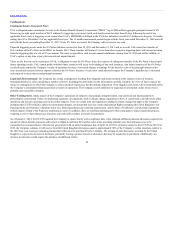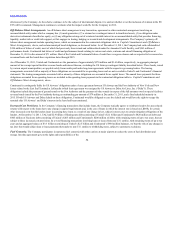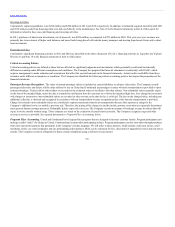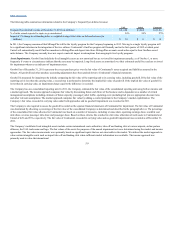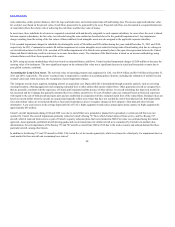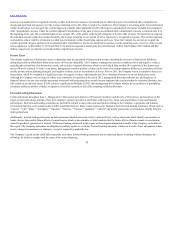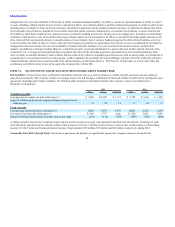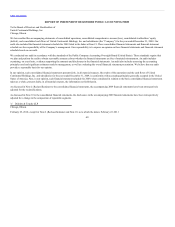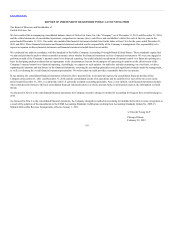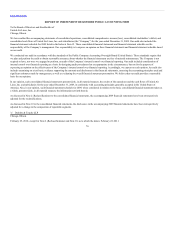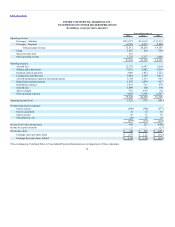United Airlines 2011 Annual Report Download - page 63
Download and view the complete annual report
Please find page 63 of the 2011 United Airlines annual report below. You can navigate through the pages in the report by either clicking on the pages listed below, or by using the keyword search tool below to find specific information within the annual report.
Table of Contents
This approach can result in different discount rates for different plans, depending on each plan’s projected benefit payments. The pension liability and future
pension expense both increase as the discount rate is reduced. Lowering the discount rate by 50 basis points (from 5.13% to 4.63%) would increase the
pension liability at December 31, 2011 by approximately $325 million and increase the estimated 2012 pension expense by approximately $41 million.
Future changes in plan asset returns, plan provisions, assumed discount rates, pension funding law and various other factors related to the participants in our
pension plans will impact our future pension expense and liabilities. We cannot predict with certainty what these factors will be in the future.
Other Postretirement Benefit Accounting. United’s postretirement plan provides certain health care benefits, primarily in the U.S., to retirees and eligible
dependents, as well as certain life insurance benefits to certain retirees reflected as “Other Benefits.” Continental’s retiree medical programs permit retirees who
meet certain age and service requirements to continue medical coverage between retirement and Medicare eligibility. Eligible employees are required to pay a
portion of the costs of their retiree medical benefits, which in some cases may be offset by accumulated unused sick time at the time of their retirement. Plan
benefits are subject to co-payments, deductibles, and other limits as described in the plans.
The Company accounts for other postretirement benefits by recognizing the difference between plan assets and obligations, or the plan’s funded status, in its
financial statements. Other postretirement benefit expense is recognized on an accrual basis over employees’ approximate service periods and is generally
calculated independently of funding decisions or requirements. The Company has not been required to pre-fund its current and future plan obligations, which
has resulted in a significant net obligation, as discussed below.
UAL’s benefit obligation was $2.54 billion and $2.49 billion for the other postretirement benefit plans at December 31, 2011 and 2010, respectively. The year-
over-year increase is due to changes in the assumptions used to value the obligation for UAL’s plan, such as the decrease in the discount rate.
The calculation of other postretirement benefit expense and obligations requires the use of a number of assumptions, including the assumed discount rate for
measuring future payment obligations and the health care cost trend rate. UAL determines the appropriate discount rate for each of its plans based on current
rates on high quality corporate bonds that would generate the cash flow necessary to pay plan benefits when due. United’s weighted average discount rate to
determine its benefit obligations as of December 31, 2011 was 4.93%, as compared to 5.15% for December 31, 2010. Continental’s weighted average discount
rate to determine its benefit obligations as of December 31, 2011 was 4.78%, as compared to 4.97% for December 31, 2010. The health care cost trend rate
assumed by United and Continental for 2011 was 8% and 7.5%, respectively, as compared to assumed trend rate for 2012 of 7%. A 1.0% increase (decrease)
in assumed health care trend rates would increase (decrease) UAL’s total service and interest cost for the year ended December 31, 2011 by $21 million and
$(18) million, respectively. A one percentage point decrease in the weighted average discount rate would increase UAL’s postretirement benefit liability by
approximately $308 million and increase the estimated 2011 benefits expense by approximately $21 million.
UAL selected the 2011 discount rate for each of its plans by using a hypothetical portfolio of high quality bonds at December 31, 2011 that would provide the
necessary cash flows to match the projected benefit payments. Prior to 2011, the discount rate was selected using a cash flow matching technique where
projected benefit payments were matched to a yield curve based on high quality bond yields as of the measurement date. This change increased the discount
rate which lowered the present value of the liability by approximately $200 million.
Detailed information regarding the Company’s other postretirement plans, including key assumptions, is included in Note 9 to the financial statements in
Item 8 of this report.
Actuarial gains or losses are triggered by changes in assumptions or experience that differ from the original assumptions. Under the applicable accounting
standards for postretirement welfare benefit plans, those gains and
62



